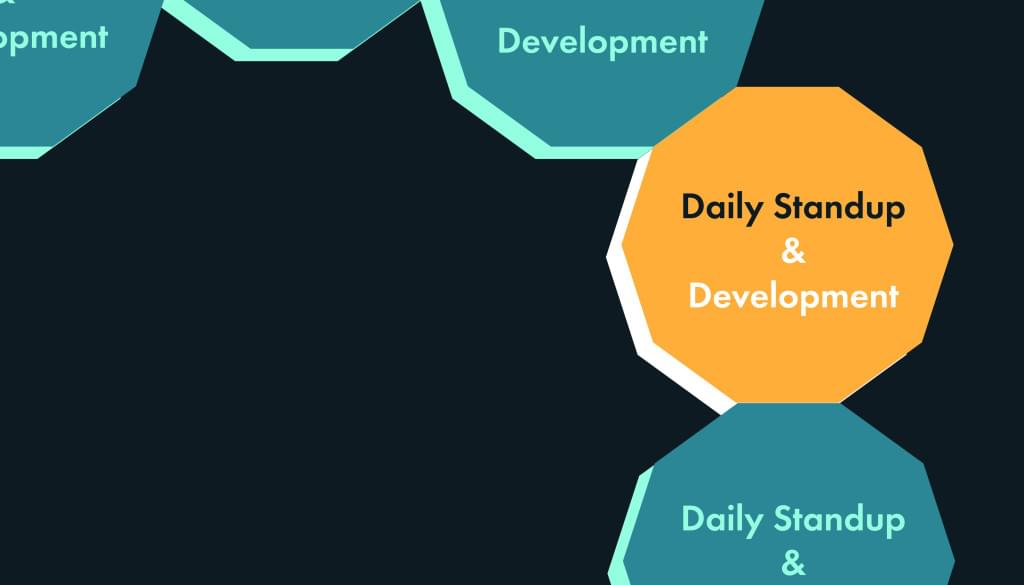Scrum Rituals: Daily Standup

The following is an extract from our book, Scrum: Novice to Ninja, written by M. David Green. Copies are sold in stores worldwide, or you can buy it in ebook form here.
Key Takeaways
- The daily standup is a critical part of scrum, providing a regular opportunity for team members to share their progress and get help if they’re facing any obstacles. It’s also a chance for anyone outside the team to understand the team’s current work and progress.
- The standup is traditionally limited to 15 minutes to ensure it is focused and convenient. All team members are expected to be present, participate actively, and avoid distractions like laptops and other devices. The scrum master is responsible for enforcing the time limit and rules of the standup.
- Each team member should be prepared to present their current work in a clear and understandable manner. The scrum master asks each person three questions: What have you done since the last standup? What do you plan to do until the next standup? Is there anything blocking your progress?
- The daily standup is also an opportunity to update the status of stories on the team’s shared scrum board, switch pairs in pair programming, and let each other know about upcoming vacations or expected story completions. The scrum master may make team-relevant announcements at the end of the standup if there’s time left.
Daily Standup
The daily standup is probably the first ritual that comes to mind when people think of scrum. The daily standup provides a heartbeat for the team, giving everybody a regular opportunity to get a clear picture of what other people on the team are working on, and what the status of the project as a whole is.

Objective
The purpose of the daily standup is to give everybody on the team an opportunity to share the status of the work they’re doing, and get help if anything is blocking their progress. Everyone on the team should pay attention as their teammates report, so they can have a clear picture of the status of the complete iteration they’re all working on.
This is also an opportunity for anybody outside the team who’s interested in knowing what the team is working on to find out how stories are progressing, and what’s likely to be worked on next. Only team members are allowed to present at the daily standup, but anybody in the company may attend, and visitors should be invited to participate as silent observers.
Traditionally, the daily standup is limited to 15 minutes. It’s a short ritual, and it’s kept short and made as convenient as possible so that everyone can commit to being present, participating actively, and paying attention while other people are speaking. Everyone is expected to stand, both so that they pay attention, and to encourage all participants to play their part in keeping the ritual short and focused. Most teams try to hold the standup away from their desks, and discourage people from using laptops and other devices during the ritual.
Note: Keeping the Standup to Time
Keeping the daily standup within its 15 minute time box is the responsibility of the scrum master, but everybody on the team should feel empowered to enforce the rules of the standup, so the time box doesn’t get broken. That includes making sure everybody starts on time, pays attention, and doesn’t allow interruptions from guests.
Different teams will choose different times of day to hold the stand up. Often first thing in the morning, or right before lunch, can be good times. These are natural breaks in the day that are usually common to most people on the team, so a 15 minute standup won’t disrupt the focus needed for longer blocks of programming time.
Finding a time that works for everybody can be challenging for teams that aren’t co-located, especially when some members of the team are in different time zones. Nobody should be allowed to miss the standup on a regular basis, but there’s always room for flexibility, as long as the objectives of the daily standup are being met. Even if not everybody can make it to a specific standup, the scrum master should keep the ritual for anyone who is there.
Sometimes teams may need to come up with their own systems, and iterate on these reflectively from sprint to sprint. The priority should be on keeping the rituals brief, maintaining them reliably, and making sure they provide the intended value without creating undue interruption.
Every team member should be present and available at the time of the standup. The only preparation necessary is for each team member to think about how to present the work being done at the moment in such a way that it’ll be clear and understandable to everybody. if a team member is having blockers that relate to people outside the team, it’s reasonable to let those people know to be prepared to discuss the issue immediately after the standup.
There’s no special preparation needed by the scrum master before the standup. A good scrum master may check the status of the stories being worked on before the standup, to see if any changes are pending, or may arrange to round up any guests the scrum master thinks should be there who don’t normally attend.
Three Questions
The core of the daily standup consists of the scrum master going around the team and asking every person three questions:
-
What have you done since the last stand up?
-
What do you plan to do until the next standup?
-
Is there anything blocking your progress?
It should be as simple as that. Every member of the team answers each one of these questions, and once the last person has finished reporting, the standup is over. Unless the scrum master has urgent announcements that need to be made for the entire team, everyone who doesn’t have specific business with another person attending the standup should be free to get back to work.
Warning: Beware Guests at Standups
There’s a strong tendency for people attending standups as guests to ask questions, introduce new information, or start discussions that don’t relate to the entire team. Anyone who isn’t a member of the development team shouldn’t be speaking during standup. The scrum master needs to be strong about suppressing this kind of behavior. People of high rank in the organizational hierarchy don’t get special treatment in this regard. Everyone needs to respect the time and attention of the engineers, and allow them to get back to work as quickly as possible.
In answering the questions of the standup, each engineer needs to be prepared with a succinct description of what they’ve worked on, what they plan to work on next, and whether they have any blockers. This is a skill that takes practice, and the scrum master should be prepared to coach every team member on how to answer these questions in a way that makes the best use of the time available.
If one person’s report invites a little bit of back-and-forth discussion, and the conversation has relevance for the entire team, the scrum master may permit it. But this type of interaction must be limited to respect the time box of the standup. If the conversation gets beyond a few sentences, the scrum master should step in and suggest that the conversation be taken off-line. A good scrum master will keep track of what conversations need to happen at the end of the standup, and follow up on their status afterward.
Other Status Updates
Some teams choose to update the status of their stories on the team’s shared scrum board during the daily standup, while others prefer to do it individually as the stories get completed. In either case, the standup should be an opportunity to make sure everybody has updated the status of everything they’re working on, and that everybody on the team is aware of what everybody else is working on.
For teams that are doing pair programming, the standup can be an opportunity to switch pairs, or switch stories. Some teams that do pairing prefer that every story have one engineer seeing it through from beginning to end. It can be beneficial for the flexibility of the team to allow multiple people to pair on the same story, particularly if it relates to some core functionality that’s worth sharing information about. Different teams will come up with different approaches, but the standup is a good place to make changes on a daily basis.
Standups are also a good opportunity for team members to let each other know if they expect to complete a story before the next standup, and if they have vacation time coming up. Knowing the availability of other people on the team can inspire teammates to plan their work around upcoming stories, and arrange to switch pairs or allocate resources appropriately.
Note: What to work on next?
If an engineer is unclear about what should be worked on next, the priority of the sprint backlog should guide these decisions. The product owner is responsible for grooming the sprint backlog throughout the sprint, and making sure that it always represents the priority in which the stories should be addressed.
Unless there’s a compelling technical reason, any engineer without a current story should start working on the story at the top of the backlog with the next highest priority, regardless of specialization. Following this pattern can provide an opportunity for engineers to pair with somebody in an area where they have less experience, and help spread knowledge about the entire code base throughout the team.
Finally, the scrum master may make announcements that have relevance to the entire team at the end of the standup—once everybody has had a chance to report, and only if there’s time left. This shouldn’t become a replacement for any organizational team building that may come from company meetings, team lunches, and other gatherings.
Every team member should be present and available at the time of the standup. The only preparation necessary is for each team member to think about how to present the work being done at the moment in such a way that it’ll be clear and understandable to everybody. if a team member is having blockers that relate to people outside the team, it’s reasonable to let those people know to be prepared to discuss the issue immediately after the standup.
There’s no special preparation needed by the scrum master before the standup. A good scrum master may check the status of the stories being worked on before the standup, to see if any changes are pending, or may arrange to round up any guests the scrum master thinks should be there who don’t normally attend.
Three Questions
The core of the daily standup consists of the scrum master going around the team and asking every person three questions:
-
What have you done since the last stand up?
-
What do you plan to do until the next standup?
-
Is there anything blocking your progress?
It should be as simple as that. Every member of the team answers each one of these questions, and once the last person has finished reporting, the standup is over. Unless the scrum master has urgent announcements that need to be made for the entire team, everyone who doesn’t have specific business with another person attending the standup should be free to get back to work.
Warning: Beware Guests at Standups
There’s a strong tendency for people attending standups as guests to ask questions, introduce new information, or start discussions that don’t relate to the entire team. Anyone who isn’t a member of the development team shouldn’t be speaking during standup. The scrum master needs to be strong about suppressing this kind of behavior. People of high rank in the organizational hierarchy don’t get special treatment in this regard. Everyone needs to respect the time and attention of the engineers, and allow them to get back to work as quickly as possible.
In answering the questions of the standup, each engineer needs to be prepared with a succinct description of what they’ve worked on, what they plan to work on next, and whether they have any blockers. This is a skill that takes practice, and the scrum master should be prepared to coach every team member on how to answer these questions in a way that makes the best use of the time available.
If one person’s report invites a little bit of back-and-forth discussion, and the conversation has relevance for the entire team, the scrum master may permit it. But this type of interaction must be limited to respect the time box of the standup. If the conversation gets beyond a few sentences, the scrum master should step in and suggest that the conversation be taken off-line. A good scrum master will keep track of what conversations need to happen at the end of the standup, and follow up on their status afterward.
Other Status Updates
Some teams choose to update the status of their stories on the team’s shared scrum board during the daily standup, while others prefer to do it individually as the stories get completed. In either case, the standup should be an opportunity to make sure everybody has updated the status of everything they’re working on, and that everybody on the team is aware of what everybody else is working on.
For teams that are doing pair programming, the standup can be an opportunity to switch pairs, or switch stories. Some teams that do pairing prefer that every story have one engineer seeing it through from beginning to end. It can be beneficial for the flexibility of the team to allow multiple people to pair on the same story, particularly if it relates to some core functionality that’s worth sharing information about. Different teams will come up with different approaches, but the standup is a good place to make changes on a daily basis.
Standups are also a good opportunity for team members to let each other know if they expect to complete a story before the next standup, and if they have vacation time coming up. Knowing the availability of other people on the team can inspire teammates to plan their work around upcoming stories, and arrange to switch pairs or allocate resources appropriately.
Note: What to work on next?
If an engineer is unclear about what should be worked on next, the priority of the sprint backlog should guide these decisions. The product owner is responsible for grooming the sprint backlog throughout the sprint, and making sure that it always represents the priority in which the stories should be addressed.
Unless there’s a compelling technical reason, any engineer without a current story should start working on the story at the top of the backlog with the next highest priority, regardless of specialization. Following this pattern can provide an opportunity for engineers to pair with somebody in an area where they have less experience, and help spread knowledge about the entire code base throughout the team.
Finally, the scrum master may make announcements that have relevance to the entire team at the end of the standup—once everybody has had a chance to report, and only if there’s time left. This shouldn’t become a replacement for any organizational team building that may come from company meetings, team lunches, and other gatherings.
Frequently Asked Questions (FAQs) about Scrum Rituals: Daily Standup
What is the main purpose of a daily standup in Scrum?
The primary purpose of a daily standup, also known as a daily Scrum, is to synchronize the team’s activities and plan for the next 24 hours. It’s a quick, time-boxed event for the Scrum Team to inspect their progress towards the Sprint Goal and adapt the Sprint Backlog as necessary. It promotes quick decision-making, immediate problem-solving, and effective collaboration.
How long should a daily standup last?
A daily standup should ideally last no more than 15 minutes. This is to ensure that the meeting remains focused and efficient. If any discussion needs more time, it should be taken offline after the standup.
Who should attend the daily standup?
The daily standup is attended by the Scrum Team, which includes the Product Owner, the Scrum Master, and the Development Team. However, it’s primarily a meeting for the Development Team. Other stakeholders can attend but as observers only.
What are the typical questions asked during a daily standup?
During a daily standup, each team member typically answers three questions: What did I do yesterday that helped the Development Team meet the Sprint Goal? What will I do today to help the Development Team meet the Sprint Goal? Do I see any impediment that prevents me or the Development Team from meeting the Sprint Goal?
What is the role of the Scrum Master during a daily standup?
The Scrum Master ensures that the Development Team conducts the daily standup. They help the team keep the meeting within the 15-minute time-box and facilitate the discussion if necessary. The Scrum Master also helps remove any impediments that the team identifies during the meeting.
Can the daily standup be skipped if there’s nothing new to report?
No, the daily standup should not be skipped even if there’s nothing new to report. It’s an opportunity for the team to synchronize their work and plan for the day. Even if there’s no progress, discussing the reasons can be beneficial.
What should be done if the daily standup is taking longer than 15 minutes?
If the daily standup consistently takes longer than 15 minutes, it may indicate that the team is getting into problem-solving during the meeting. In such cases, the Scrum Master should remind the team to focus on synchronization and planning, and take detailed discussions offline.
How can a remote team effectively conduct a daily standup?
Remote teams can use video conferencing tools to conduct daily standups. It’s important to ensure that everyone has a chance to speak and that the team maintains the discipline of keeping the meeting to 15 minutes.
What is the difference between a daily standup and a status meeting?
While both involve sharing updates, a daily standup is not a status meeting. The focus of a daily standup is on planning and synchronization towards the Sprint Goal, not just reporting progress. It’s a forward-looking meeting, while a status meeting is often backward-looking.
Can the daily standup be used to address non-project related issues?
The daily standup should primarily focus on progress towards the Sprint Goal. However, if a non-project related issue is impacting the team’s ability to work effectively, it can be brought up. The Scrum Master should then help address it outside the meeting.
I've worked as a Web Engineer, Writer, Communications Manager, and Marketing Director at companies such as Apple, Salon.com, StumbleUpon, and Moovweb. My research into the Social Science of Telecommunications at UC Berkeley, and while earning MBA in Organizational Behavior, showed me that the human instinct to network is vital enough to thrive in any medium that allows one person to connect to another.



